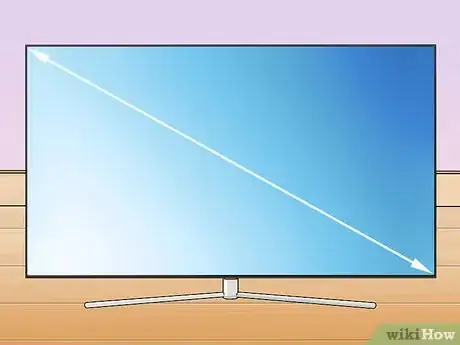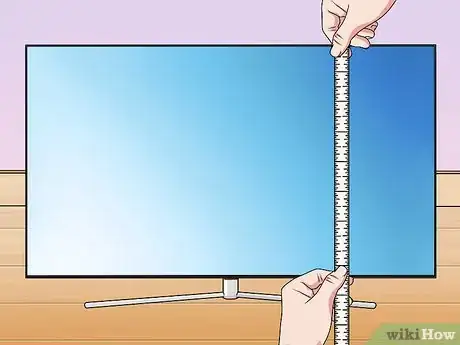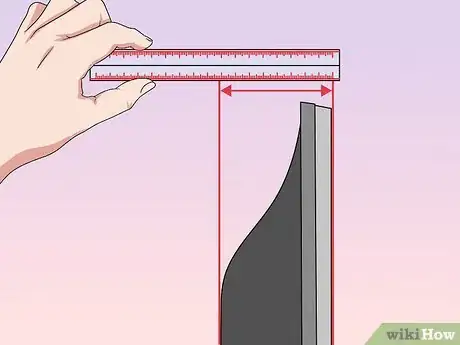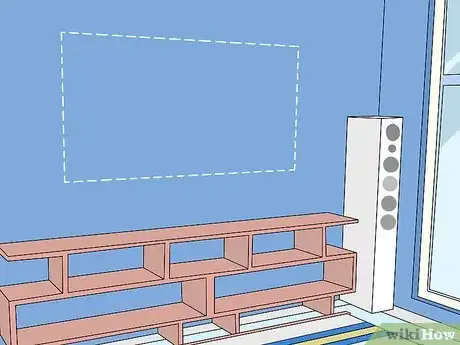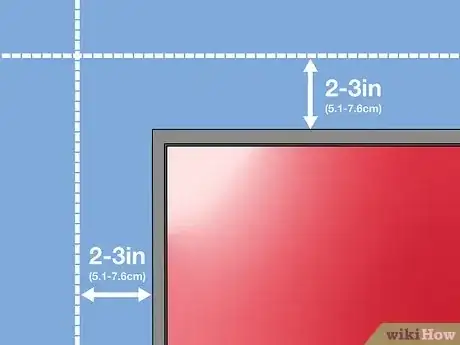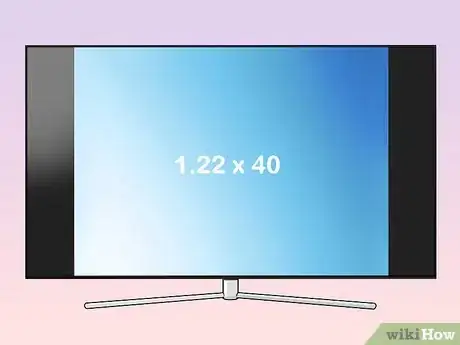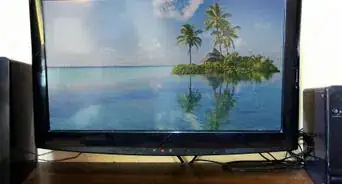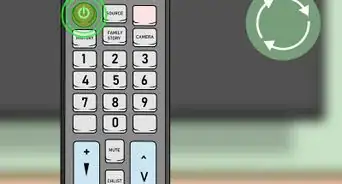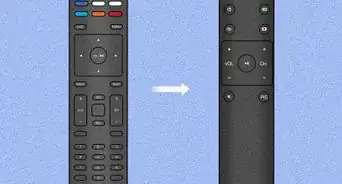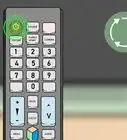This article was co-authored by wikiHow staff writer, Travis Boylls. Travis Boylls is a Technology Writer and Editor for wikiHow. Travis has experience writing technology-related articles, providing software customer service, and in graphic design. He specializes in Windows, macOS, Android, iOS, and Linux platforms. He studied graphic design at Pikes Peak Community College.
There are 8 references cited in this article, which can be found at the bottom of the page.
wikiHow marks an article as reader-approved once it receives enough positive feedback. This article has 29 testimonials from our readers, earning it our reader-approved status.
This article has been viewed 1,631,991 times.
Learn more...
As technology continues to improve, TVs continue to get bigger and better. If you’ve recently upgraded to a sleek new model, you may be wondering how best to measure it for display. Perhaps you want to know if a TV you are considering purchasing will fit on your stand. Luckily, measuring a TV is incredibly simple, and only takes a few seconds in most cases. This wikiHow article teaches you how to properly measure a TV and make sure it fits perfectly in your space.
Things You Should Know
- Measure the screen diagonally from corner to corner to learn the screen size.
- Measure the height and width of the TV frame to find out if it will fit on your stand or cabinet.
- Place a TV in an area that has a few inches to spare on all sides for proper ventilation.
Steps
Find the Dimensions
-
1Measure the screen diagonally from corner to corner. This is how you confirm the manufacturer's advertised size. Regardless of whether you're measuring a flat-screen TV or an old CRT television, start with the end of your tape measure at the top left corner of the screen and extend it to the bottom right corner. Measuring the screen diagonally will give you the standard screen dimension that manufacturers use to advertise the size of their TVs.[1]
- Some common sizes for TVs based on the diagonal dimensions of the screen include 24 in (61 cm), 28 in (71 cm), 32 in (81 cm), 42 in (110 cm). 48 in (120 cm), 60 in (150 cm), 65 in (170 cm), 70 in (180 cm), and 85 in (220 cm).[2]
- You can also find TVs with screens as big as 98 in (250 cm) or larger.
- The largest TV currently on the market for household entertainment is LG's 8K DVLED TV at a whooping 325 in (830 cm).[3]
Tip: Only measure the screen itself, not the bezel, or the frame surrounding the screen’s outer edges.[4]
-
2Run your tape measure horizontally from side to side to find the width. This time, measure from the far left edge of the TV to the far right edge, including the bezel on both ends. The number you get will be the overall width, which should be a few inches less than the advertised screen size.
- For example, a TV listed as 60 in (150 cm) will only be about 52.3 inches (133 cm) wide.
- Your TV’s width is its most crucial measurement. This is how you can find out if a TV will fit on your stand or cabinet.
Advertisement -
3Measure from top to bottom to get the height. Now, stretch your tape measure from the upper edge of the TV to the lower edge on the same side. Doing so will give you the overall height. Most newer TVs have a height that’s around 56% of the total width.
- For example, a TV with a screen that is advertised as 48 in (120 cm) will be about 42 inches (110 cm) wide and have a height of around 25–27 inches (64–69 cm).
- Generally speaking, height doesn’t matter as much as width. However, the vertical dimension could end up making a difference when you're deciding where to place your TV.
-
4Find the depth of the TV by measuring from front to back. This may be a little tricky if the backside of the TV is tapered. In this case, it can help to hold another long, flat object (such as a yardstick) against the farthest point from the front. Hold it parallel to the screen. Then measure the distance between the screen and the reference object. If that’s not an option, you may also be able to get away with simply eyeballing it.
- You may need to consider the depth of your TV in order to guarantee that it will fit an existing cabinet or stand.
- TVs are continually being redesigned to take up less space. These days, many flat screen models are less than 10 inches (25 cm) deep with a stand attached, and as thin as 3 inches (7.6 cm) without. Older CRT televisions are much thicker. You will need to consider the depth with these more than any other TV.[5]
Make Sure the TV Fits
-
1Measure your intended display space. If you haven't already, find the exact height and width of the area where you want to place your TV. If your TV is particularly thick, you may also need to note the depth of cabinets, stands, or entertainment centers to determine whether they're big enough to hold your TV.[6]
- For maximum accuracy, round off your measurements to the nearest 1⁄2 inch (1.3 cm).
- Jot the dimensions of your display space on a piece of paper and keep them with you when you're shopping around for your new TV.
-
2Allow for an extra 2–3 in (5.1–7.6 cm) of room in your display space. Make sure the stand or section of wall you’ll be placing your TV has a few inches to spare on all sides. That way, you can ensure that it fits comfortably and avoid any unpleasant surprises when it comes time to set it up.
- Having a few inches of extra space on all sides of your TV allows for proper ventilation, which can prevent performance issues caused by overheating.
- You’ll need to know your TV’s width and height if you intend to mount it on the wall. If you want to place it on a stand or in an enclosed cabinet, you’ll also need to factor in its depth.
- When mounting a TV to a wall, be sure to get a wall mount that is rated for the size and weight of your TV. You don't want your TV to fall because it was too big for the wall mount.
-
3Pick out a TV big enough to see clearly from where you’ll be sitting. A 50 in (130 cm) screen may sound impressive, but it could be a little underwhelming if you’re watching from the opposite side of the room. When it comes to arriving at a reliable size estimate, a good rule of thumb is to multiply the distance between your seating area and TV in inches by 0.84.[7]
- If you’re going to be sitting about 72 inches (180 cm) away from your TV, for instance, a 60 in (150 cm) will provide optimum visibility.
-
4Understand your TV's aspect ratio to enjoy the best picture. The term “aspect ratio” refers to the relation between the width and height of a TV’s display image. Newer widescreen TVs normally have an aspect ratio of 16:9. This means that the picture has a height of 9 inches/cm for every 16 inches/cm of width.[8]
- Standard TVs tend to be older CRT models. They have an aspect ratio of 4:3. As such, they squeeze the picture into a square image with an overall smaller area, while widescreen TVs take advantage of their added width to display the full image in its proper dimensions.[9]
- A standard (4:3) TV and a widescreen TV could have the same diagonal screen measurement, but the picture would look quite different for each.
-
5Multiply standard screen sizes by 1.22 to get the same aspect ratio on a widescreen TV. If you’re thinking about upgrading to a widescreen TV but you’d prefer to continue watching in a 4:3 format, multiply the diagonal screen measurement of the old TV by 1.22. The resulting number will tell you how big your new TV would have to be to produce the same size 4:3 image.
- If you currently have a 40 in (100 cm) standard TV, you’ll need a widescreen TV with a screen that’s at least 50 inches (130 cm) to make sure your picture doesn't get smaller.
- Standard TVs also have a smaller resolution than new widescreen HDTVs. So the same-size picture on a standard TV will have less detail than on a widescreen HDTV.
Community Q&A
-
QuestionI have the width (16') and height (9') of a big screen for a projector. (1.) How do I determine the measurement for the diagonal and (2.) If the projector is 14' from the screen, what is the aspect ratio?
 Community Answer(1) Use the Pythagorean theorem. Diagonal is the square root of (height squared + width squared). If your measurements are exact, the diagonal is 18.4'. (2) Aspect ratio is the ratio of horizontal to vertical on the screen. This ratio does not change with viewing distance.
Community Answer(1) Use the Pythagorean theorem. Diagonal is the square root of (height squared + width squared). If your measurements are exact, the diagonal is 18.4'. (2) Aspect ratio is the ratio of horizontal to vertical on the screen. This ratio does not change with viewing distance. -
QuestionIs it normal for a TV that says 55" to measure smaller diagonally?
 Community AnswerA TV that says 55" should be 55" diagonally and there are no exceptions to that. Either you might be measuring the TV wrong or there was an external error.
Community AnswerA TV that says 55" should be 55" diagonally and there are no exceptions to that. Either you might be measuring the TV wrong or there was an external error. -
QuestionWhat is the exact width of a 60" TV?
 Community AnswerIt depends on the shape of the TV (i.e., square or rectangle) but most often it will be around 53"x28".
Community AnswerIt depends on the shape of the TV (i.e., square or rectangle) but most often it will be around 53"x28".
References
- ↑ https://www.livingspaces.com/inspiration/ideas-advice/guides/tv-stand-size-guide
- ↑ https://tvsguides.com/popular-tv-screen-sizes/
- ↑ https://www.curvedview.com/worlds-biggest-tv-size/
- ↑ https://www.reference.com/technology/measure-television-screen-size-17fddce095719405
- ↑ https://www.reinisfischer.com/5-best-flat-screen-tvs-50-inches-and-more-buy-online
- ↑ https://www.digitaltrends.com/home-theater/what-size-tv-to-buy/
- ↑ http://www.crutchfield.com/S-Ml4iiPqKEBl/learn/learningcenter/home/TV_placement.html
- ↑ https://www.rtings.com/tv/learn/what-is-the-aspect-ratio-4-3-16-9-21-9
- ↑ https://www.rtings.com/tv/learn/what-is-the-aspect-ratio-4-3-16-9-21-9
About This Article
1. Measure your screen diagonally from corner to corner to find the manufacturer's advertised size.
2. Measure the height and width of the TV (including the frame) to make sure it will fit on your stand or cabinet.
3. Measure how thick your TV is to find out if there is enough room on your shelf.
4. Allow a few inches on all sides or your TV for proper ventilation.
To learn how to make sure a TV will fit in your display space, scroll down!
